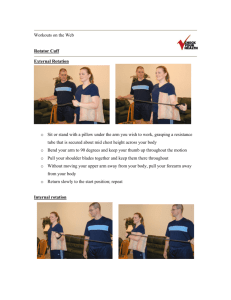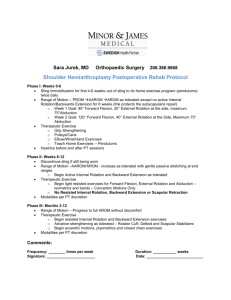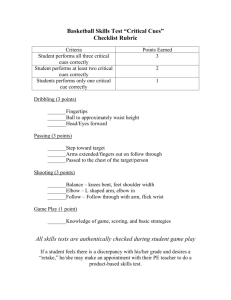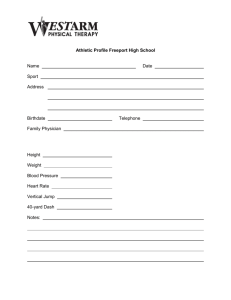Kinesiology Movement Analysis - Rowan University
advertisement
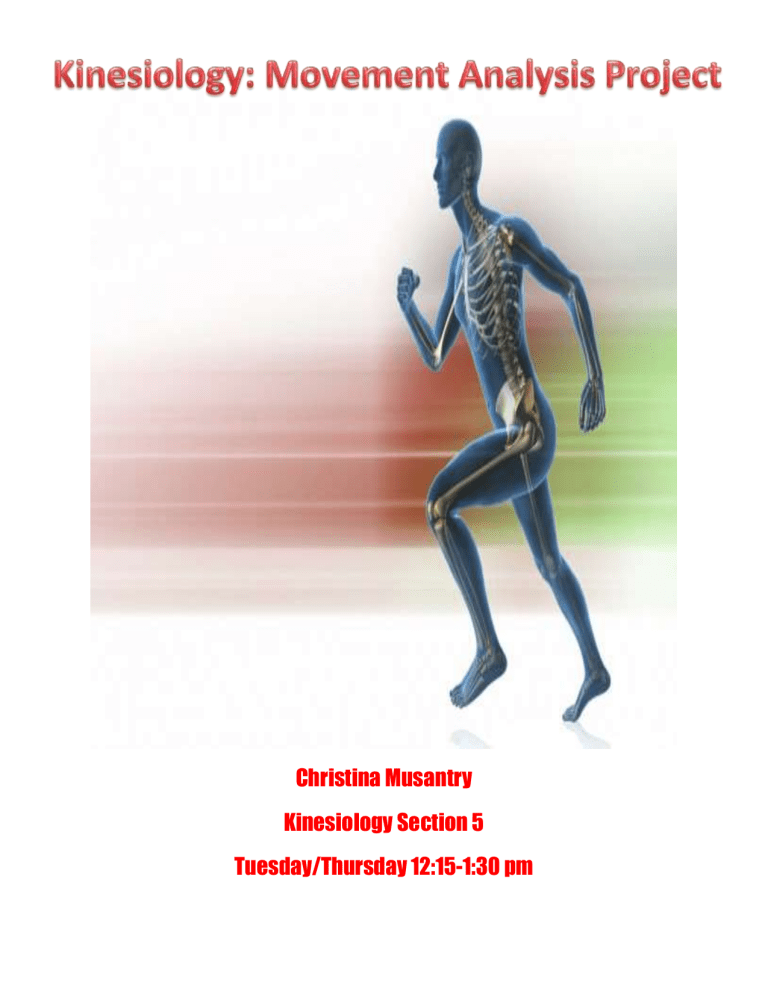
Christina Musantry Kinesiology Section 5 Tuesday/Thursday 12:15-1:30 pm 2. Demographics: Name: Christina Musantry Birth Date: Age: 20 Height: 62 in 157.48 cm 01/11/1993 Weight: Gender: 120 lbs 54.43 kg BMI: F 21.1 3. Review of Physical History: Please answer the following in full detail. If no answer is available, please write “None.” 1. List any medical conditions that can affect your physical activity: Scoliosis_ 2. List any medications that you are currently taking and why: _Naproxen- post surgery pain. 3. List any past surgeries: 3 hernias removed in 2000. All four wisdom teeth removed in April 2011. Ulnar nerve anterior transposition- August 2012. 4. List any past or current injuries: 4 concussions due to basketball and softball in 2006-2008. Elbow pain from throwing side arm since 2006. 5. List your occupation and any physical related activities you are involved in: I am currently a soccer instructor at Little Kicks Soccer. I teach 3-6 year olds motor skills needed in the game of soccer. I am also involved in multiple intramural sports here at Rowan University through my sorority. 4. Movement Goals: Improving strength in left leg by doing leg extensions and increasing in weight as needed. Improving agility and endurance by participating in cycling classes offered here at Rowan University. I want to continue to try and gain my throwing arm back. Various machines at the gym will help me gain muscle memory back but I would like to improve my form to prevent further injuries. 5. Initial Summary: While calculating my BMI, it had said that I am at a normal body weight for my height and size. Meanwhile, I feel as though I do not exercise as much as I really should. I would really like to improve the muscle mass on my left side because due to playing sports my whole life, my right arm and leg are much stronger than the left ones. By going to the gym and adding just a little bit of weight each time I go to the left side and keeping the weight at normal on my right side I will be successful with evening myself out. Another improvement that is extremely important to me is gaining my throwing arm back. I had surgery about 1 year ago, and I haven’t been able to pick up a softball and correctly throw it since. I would love to play the sport again, so I will definitely be motivated to gain the muscle memory back and start playing. I will go to the gym as well as have a catch with friends as long as I can, hopefully increasing in time as I go along. Range Of Motion Assessment 1. Cervical Spine Neutral Position Neutral Position Frontal View Sagittal View Lateral Flexion Rotation Flexion Extension 2. Glenohumeral Joint (Shoulder) Neutral Position Abduction For Abduction Extension Neutral Position Flexion For Flexion & Extension Neutral Position For Internal and External Rotation Internal Rotation External Rotation 3. Elbow Region (Humeroulnar Joint) Flexion Extension Radioulnar Joint Mid-Supination Supination Pronation Neutral Position 4. Radiocarpal Joint (Wrist) For Flexion and Extension Neutral Position Flexion For Ulnar and Radial Devation Neutral Position Extension Radial Deviation Ulnar Deviation 5. Acetabulofemoral Joint (hip) Flexion Neutral Position Extension Internal Rotation Abduction External Rotation 6. Tibiofemoral Joint (knee) Flexion Extension For achieving my goals, there are a few range of motion exercises that I would need to work on. Due to my active lifestyle when I was younger, a few motions aren’t as strong as they should be for a 20 year old female girl. I used to be a catcher in softball, so one range of motion that really hurt trying to do was the internal rotation of the acetabulofemoral joint. I was barely able to turn my leg that much without shaking and hurting. That is one thing that I think will definitely be better if I improve it now rather than later in life through physical therapy. I can go to the gym and work with weights and stretching exercises in order to build up those muscles to keep my leg in that position for an extended period of time. Another range of motion exercise that was difficult for me was supination on my radioulnar joint because I had surgery on it about a year ago. I had to get my nerves moved onto a different part of my elbow which affects my range of motion on my elbow. I used to go to physical therapy to regain all those muscles, but now that I have stopped my stretch on my arm is not as strong as it was. My goal is to build up the muscles in my right arm by doing band exercises and motions with weights in order to stretch before I start with the weights for a stronger arm. Postural Analysis: Anterior View Anterior View When evaluating my posture, doctors always said that I lean a little bit more to the right side of my body. Because of my scoliosis, my right shoulder is higher than my left one. When someone looks at me, it is hard to tell that I have scoliosis because you can’t really see that my shoulders aren’t lined up correctly. With my feet, however, you can notice that I do have a little bit of an internally rotation of the hip happening when I stand straight. Doctors have never diagnosed this as a problem, but other people have noticed that I walk with one foot slanted inward more than the other. Overhead Squat Assessment: Anterior View Sagittal View Posterior View While viewing and participating in the overhead squat assessment, I noticed one thing from each picture that I can definitely work on in order to get a better posture. In the anterior view, I noticed that I would be on the balls of my feet when I got low in the squat position. In the sagittal view, my arms would fall forward during the squat position. Lastly, although this isn’t a main point that we assess when looking at the posterior view, it is clearly noticeable that my right hand is higher than my left. That could be attributed because of my scoliosis, but it was just something extremely noticeable when looking at these pictures. Gait Analysis WALKING: Heel Off Flat Foot RUNNING: Toe Off Swing Phase Heel Strike Foot Flat Mid-Stance Heel-Off Toe-off and Start of Swing Foot Flat After Swing While recording and observing the video that I took for my gait analysis, I have noticed a few good and bad things about the way I run and walk. While walking, I noticed that I barely pick up my feet when I walk. You can observe this because my swing is a very quick phase that my foot is really low to the ground, while other people take bigger steps. Another thing I realized is that I hunch over a little bit when walking; so I would need to work on my posture in order to have a better gait analysis next time. While observing the running portion, I thought that most of my body movements were pretty good. The only thing that I would like to change here is making bigger strides, which still comes down to having a bigger swing and taking my foot a little bit higher off the ground. There are multiple times where I find myself scuffing up my shoes because I don’t pick up my feet, so that is something I definitely need to work on. My posture is much better when running, as you can tell in the pictures that I am standing upright and my hands are in a good position to keep me going. Corrective Exercise Program: Lower Extremities Throughout my life, there have always been two corrective exercises that I have needed to repeatedly do in order to gain muscle and keep it in my legs and ankles. Keeping these body parts strong are essential when trying to run for a long period of time, which has been my longtime goal for a while. One exercise that would benefit me would be completing squats. Squats would help my knees and each time I go to a physical therapist that is the one exercise that they force me to do every time I am there. Another exercise that I would need to do is the Achilles heel up exercise. Whenever I play a sport that involves planting my feet and turning, I suffer from pain in my Achilles tendon. This exercise is easy to do and involves no equipment because it can be done on stairs inside or outside a person’s house. The picture above is the Achilles tendon exercise that I would partake in to strengthen my legs and ankles for agility exercises. Playing basketball my whole life, this has always been a problem that I have suffered and this exercise I would do before games and practices using the bleachers in the gym. It would only take 5 minutes to complete, but it was an essential exercise to do in order to not have pain during and after the game. The picture above shows a woman partaking in squats. Squats are one of the many ways to work out a persons behind and knees. Whenever I participate in squats, my knees crack because of years being a softball catcher. Although my equipment had knee savers, I never did this exercise as much as I should have. Another way to add to this exercise would be to hold weights while participating in the squat position because it would challenge myself throughout holding the position. Another variation of squats that I used to do would be wall sits, where I would put myself next to a wall and then bend my knees so that they make a 90 degree angle. Getting down to that angle was always important in order to get the most out of this exercise. I never used this exercise as much as I should have, but I recently changed my ways and incorporate this into my daily work out to hopefully save what’s left of my knees. Corrective Exercise Program: Upper Extremities: There are not many upper extremity exercises I can do without causing great paint to my elbow. However, doing crunches is one way that I can work out, and not have to ice my arm when I get back. Having elbow surgery and complications after it has definitely changed my work out routine. One way that the physical therapist told me to work out was by using arm bands. Arm bands help strengthen the muscle that I lost due to surgery. Doing both work outs are a health way to keep me active and to one day, get back to sports 100%. This picture demonstrates someone doing the crunches that I do on a daily basis. Before I go to sleep, I usually do about 50 to each side. Doing them before I go to bed means that I will always have time to do them, and that there are no excuses not to. It’s not a workout that I need to make time for during my day, and it tires me out before I have to go to sleep. This exercise is one I actually enjoy doing and it will strengthen my core each time I do it. I increase the number each week, doing more towards the weekend and less on Monday. One day I will increase my number to 100, but I do not believe that I am there yet. There are multiple arm band exercises that I can do to strengthen my arm and help get back to the way it was, this exercise is one of them. By doing this, it helps in the long run fix my radioulnar nerve. I hurt my elbow about 5 years ago and I am still working to fix it. I haven’t done arm band exercises in a while, but I feel as though if I kept up with this, it would fix the problems that I have experienced in the past to the point where I will be able to throw a softball again!
